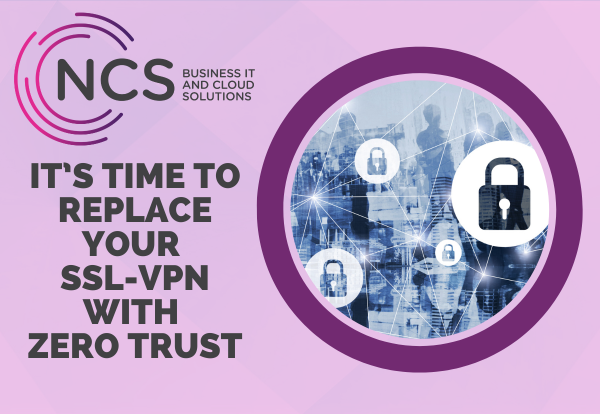Why it’s time to replace your SSL-VPN with Zero Trust
This week we’re looking at Secure Remote Access. It is evolving — is your business ready?
Why SSL-VPN (Secure Sockets Layer – Virtual Private Network) is no longer enough
Traditional SSL-VPNs were built for a different era — one where remote access was the exception, not the norm.
Today, with hybrid workforces and cloud-first strategies, VPNs expose your network to unnecessary risk. Broad access, outdated perimeter-based security, and poor scalability make them a liability in most modern IT environments.
Last year, 58% of ransomware incidents originated from compromised perimeter security appliances like VPNs and firewalls – the single largest attack method for ransomware. The most commonly compromised products came from big name vendors such as Microsoft, SonicWall, Cisco, Fortinet and Palo Alto Networks.
This represents a significant shift in ransomware tactics, with attackers moving towards systematically targeting poorly secured VPN infrastructure.
Enter Zero Trust Network Access (ZTNA)
ZTNA changes the game.
Zero Trust Network Access (ZTNA) is a security model that provides secure, adaptive, and segmented access to applications and resources. It’s based on the principle of
- verify explicitly
- use least privilege and
- assume breach.
Unlike traditional security models that operate with a perimeter-based approach—which trusts anything inside the network and focuses security on the perimeter — ZTNA continually verifies every access request regardless of location, user, or device. It assumes that every user, device, or network segment is a potential threat, and enforces strong, identity-centric access controls at every stage.
It’s a smarter, more secure way to connect users to the resources they need — and nothing more.
How does it help my business?
ZTNA is designed for agility, security, and usability— all while reducing your attack surface from today’s increasingly sophisticated cyberthreats.
- Stronger Security – no more implicit trust. Every access request is verified. By limiting access to specific applications and isolating the network, ZTNA minimises the scope of potential damage in case of a breach. Should an attacker gain access, they’re typically contained to the specific segment they infiltrated, reducing the risk of significant data loss or operational disruption.
- Improved Compliance – meet regulatory requirements with detailed access logs and controls. By limiting access to only authorised users and continuously monitoring activity, ZTNA helps organisations meet regulatory standards for data security and protection, such as GDPR and PCI-DSS. The fine-grained access controls provide a clear audit trail for demonstrating compliance.
- Better User Experience – ZTNA provides faster, more direct access to applications than traditional VPN-based access, reducing latency and improving productivity for remote and mobile users. With continuous authentication and adaptive security, users enjoy a balance of security and convenience, as they only need to reauthenticate when risk levels change
- Increased visibility – ZTNA provides a view of all access requests and network activity, enabling real-time monitoring and auditing. This visibility is critical for identifying and mitigating risks early, as well as for compliance reporting and understanding user behaviour patterns.
- Scalability and flexibility – ZTNA’s cloud-based approach to security is scalable and adaptable. As a business grows, adds resources, or adopts new applications, ZTNA accommodates these changes without requiring extensive reconfigurations. It supports a hybrid workforce by providing seamless, secure access regardless of users’ locations and BYOD (Bring Your Own Device) policies.
- Reduced risk of insider threats – with the least privilege access model, ZTNA restricts users to only the resources necessary for their roles. This limits the potential damage a compromised account or a malicious insider could cause.
How do we make the switch to ZTNA?
Transitioning to ZTNA doesn’t have to be disruptive.
Start with a readiness assessment, plan with our team, and scale up with confidence. We’ll guide you every step of the way.
Ready to Modernize Your Remote Access?
Talk to us about how ZTNA can transform your security strategy here >
Posted in News

